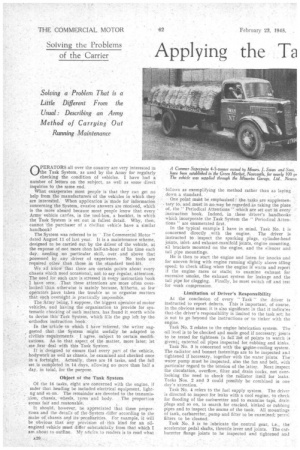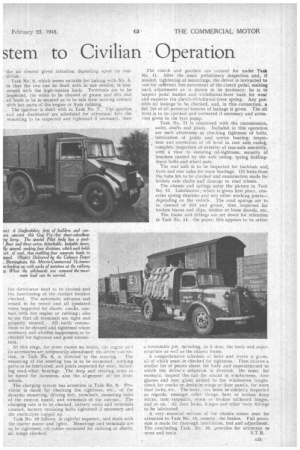Applying the Ta stern to Civilian Operation
Page 22

Page 23

If you've noticed an error in this article please click here to report it so we can fix it.
Solving the Problems of the Carrier
Solving a Problem That is a Little Different From the Usual : Describing an Army Method of Carrying Out Running Maintenance
OPERATORS all over the country are very interested in Lthe Task System, as used by the Army for regularly
• checking the condition of vehicles. I have had a number of letters on the subject, as well as some direct inquiries to the same end.
What exasperates most people is that they can get no help from the manufacturers of the vehicles in which they are interested. When application is made for information concerning the System, evasive answers are received, which is the more absurd because most people know that every Army vehicle carries, in the tool-box, a booklet, in which the Task System is set out in fullest detail. Why, then, cannot the purchaser of a civilian vehicle have a similar handbook? • The System was referred to in '. The COmmercial Motor " dated August 11 of last year. It is a maintenance scheme, designed to be carried out by the driver of the vehicle, at the expense of not more than half-an-hour of his time each day, needing no particular skill, over and above that possessed by any driver of experience. No thols are required other than those, in the .standard tool-kit. We ad know that there are certain points about every chassis which need occasional, not. to say regular, attention. The need for such care is stressed in every instruction hook I have seen. That these attentions are more often overlooked than otherwise is mainly because, hitherto, so few operators have taken the trouble so to organize matters that such oversight is practically impossible. .
The Army being, I suppose, the biggest operator of motor vehicles, and having the organization to provide for systematic checking of such matters, has found it,worth while to devise this Task System, which fills the gap left by the
orthodox instruction book. • In the article to Which I have 'referred, the writer suggested that the System might usefully be adapted to civilian requirements. I agree, subject to certain modifications. As to that aspect of the matter, more later; let me first deal with this Task System.
It is designed to ensure that every part of the vehicle, bodywork as well as chassis, be examined and checked once in a fortnight. . Actually, there are 16 tasks, and the full 'set is coMpleted in 14 days, allowing no more than half a day, in total, for the purpose.
Object of the Task System Of the 16 tasks, eight are concerned with the engine, if inder that heading be included electrical equipment, lightng and so on. The remainder are devoted to the transmis
sion; chassis, wheels, tyres and body. The proportion
seems fah and reasonable. 1 It should, however, be appreciated that these proportions and thedetails of the-System differ according to the make of;chassis and its peculiarities. For example, it will be obvious that any provision of this kind for an oilengined vehicle must differ substantiallv. from that which I am about to outline. My adyke to readers is to read what
follows as exemplifying the method rather than as laying down a standard. . . , •
One point mulct be emphasized:. the tasks are supplementary to, and must in no way be regarded as taking the place of, the " Periodical Attentions "which are set out in every instruction book. Indeed, in these .driver's handbooks which incorporate the Task System the " Periodical Attentions " are enumerated first.
In the typical example I have in mind, Task No. 1 is concerned directly with the engine. The driver is instructed to inspect the sparking plugs, cylinder-head joints, inletand exhaust-manifold joints, engine mounting, all brackets mounted on the engine, and the silencer and tail pipe mountings.
He is then to start the engine and listen for knocks and for uneven firing with engine running slightly above idling speed; to check idling when the engine is warm and report if the engine races or stalls; to examine exhaust for excessive -smoke, the exhaust system for leakage and the tail pipe for clogging. Finally, he must switch off and test for weak cotnpression.
Limitation of Driver's Responsibility At the conclusion of every " Task " the driver is instructed to report defects. This is important, of course, in the obvious sense; it is also significant in that it indicates that-the driver's responsibility is limited to the task set; he is not to go beyond the instructions or to tinker with the engine.
Task No. 2 relates to the engine lubrication system. The oil level is to be checked and made good if necessary; joints to be tested for tightness (a full list of points to watch is given),;. external oil pipes inspected for, rubbing and kinks.
Task No. 3 is concerned with the 2,1gine-coo1ing system. The radiator and bonnet fastenings are to be inspected ant tightened if 'necessary, together with the water joints. The water pump must be inspected, also the fan and belt, with particular regard to the tension of the latter. Next inspect the circulation, overflow, filter and drain cocks, not overlooking the need to check the radiator itself for leaks. Tasks Nos. 2 and 3 could possibly be combined in one day's attention.
Task No, 4 refers to the fuel supply system. The driver is directed to inspect for leaks with a cool engine, to check for flooding of the carburetter and to examine tapi, drain plugs and so on, to search for cracked, kinked or rubbing pipes and to inspect the seams of the tank; All mountings of tank, carburetter, pump and filter to be examined; petrol filters to be cleaned.
Task No, 5 is to lubricate the control gear, Le., the accelerator pedal shafts, throttle lever and joints. The carburetter flange joints to be inspected and tightened and the air cleaner given attention depending Anon its con :, dition.••••
Task No. 6, which seems suitable for linking with No. 5, in that the two can be dealt with in one Sessidon„ is;cloncerned with the high-tension leads. Terminals. are to , be ,insPected, the wires to be cleaned of grease and dirt and all leads to be se secured as to be Safe from making contact With.hot parts of the 'engine or from rubbing. • The ignition: is dealt with in Task No. .7. Mei ignitioa coil and distributor are schednied for attention; first the mounting to be inspected and tightened if necessary,. then
the distributor • headto be Cleaned and the, functioningof the contact breaker • checked, The automatic advance and retard to be tested and all insulated wires inspected for .shorts, cracks, aontact, with hot engine or rubbing; also to •see that all terminals are tight and
properly secnred. All -earth connections to he cleaned .andaightened where necessary and wireless suppressors to be checked for tightness and good connoctiOn.
_ At this. stage, for some reason no doubt, the engine and its accessories are temporarily abandoned: the driver's atten. tion, in Task No„ So is directed' to the steering. • The mounting of the steering box is to be examined, working parts tohe lubricated, and joints inspected for wear, including road-wheel hearings. ,The drop and steering arms to . be tested forlooseness, also. the alignment of the front
Wheels. . .
. The charging system has attention in. Task No. 9. Provision is made forCheekina the_ tightness,. etc., of the dynamo mounting, driving belt, terminala, mounting bolts of the control board, and terminals of the cut-out.. The charging rate is to be checked, battery vents and terminals cleaned, battery retaining bolts tightened 'if necessary and the electrolytetopped .up.
Task No. 10 follows, in rightful sequence, and deals with the, starter motor and lights. Mountings and terminals are to, he tightened, all -cables examined for rubbing or shorts; all lamps checked. The clutch and gearbox are catered for under Task No. 11. After the usual preliminary inspection and, if needed, tightening of mountings, the driver is instructed to test for sufficient free movement of the clutch pedal, making such, adjustment as is shown to be hecessary: he is to inspect pedal hushes and withdrawal-lever bush for wear and examine the clutch-Withdrawal-lever spring. Any possible oil leakage to be aliecked, and, in this connection, a full list of all potential 'sources of leakage is given. The oil level Is to be checked and corrected if necessary and attention given to the tyre pump.
Task No. 11 is concerned with the transmission, axles, shafts and joints. • Included in this operation are such attentions as checking tightness of bolts, lubrication of joints and centre bearing; inspection and correction of oil level in rear. axle, casing, complete inspection of exterior of rear-axle assernbly, with a view to ensuring. oil-tightness, security of brackets carried by the axle casing, spring holdingdown bolts and wheel nuts.
'The rear axle is to be, inspected for backlash and, front and tear axles for worn bearings: Oil leaks from the hubs are to be checked and examination made for broken axle shafts and damage to road wheels.
The chassis and springs enter the picture in Task No. 1:1. Lubrication, which is given first place, concerns spring shackles and any other working joints— depending on the vehicle. The road springs ate to be cleaned of 'dirt and grease, then inspected for broken leaves and clips, broken or loose dowels, etc.
The frame and fittings are set down for attention in Task No. 14. On paper, this appears to he rather lormidable job, including, as it does, the body and superstructure as well astthe chassis frame.
• A comprehensive schedule of bolts and rivets is given, all of which must be checked for tightness. Then follows a similar list of points about the body and superstructure to which the driver's attention is directed. He must, for example, inspeet the cab for cracks in windscreens, door glossesand rear glass; attend to the windscreen hinges, check for cracks or dents in wings or door panels, for worn door locks, etc. The body, too, mist' be similarly inspected . as regards, amongst other things, bent or broken hoop sticks, torn •tarpaulin, ...worn or broken tailboard hinges, • and so On. All door locks, hinges and other body fittings to be lubricated,
_ A very essential section of the chassis comes next for attention in Task No. 15,namely, the brakes. 14111 provision is made for thorough lubrication, test and adjustment. The concluding Task, No 16, provides for attention to tyres and tools. 'S.T.R.




















































